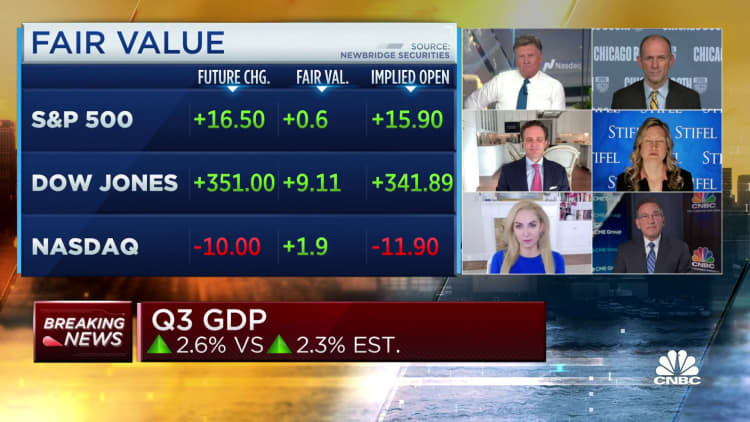
The U.S. economy registered its first positive growth of 2022 in the third quarter, the Bureau of Economic Analysis reported on Thursday, easing inflation concerns at least temporarily.
GDP, the sum of all goods and services produced between July and September, grew at an annualized rate of 2.6% during that period, according to advance estimates. This was higher than the Dow Jones forecast of 2.3%.
The data started the year with consecutive quarters of negative growth, in line with the generally accepted definition of a recession, although the National Bureau of Economic Research is often considered the arbiter of recessions and expansions.
Much of the increase was due to a narrowing of the trade deficit, which economists expect and see as a one-off event that won’t repeat itself in the coming quarters.
GDP growth also came from increases in consumer spending, nonresidential fixed investment, and government spending. The report reflected a continued shift in spending on services towards goods, with spending on the former rising 2.8%, while spending on goods fell 1.2%.
Gains were offset by declines in residential fixed investment and private inventories, the BEA said.
“Overall, while the 2.6% rebound in the third quarter outpaced the first-half losses, we do not expect the momentum to continue,” wrote Paul Ashworth, chief North American economist at Capital Economics. “Exports will fade soon and domestic demand will be hit under the weight of rising interest rates. We expect the economy to enter a mild recession in the first half of next year.”

Markets moved higher after the news, with the Dow Jones Industrial Average up more than 300 points in early Wall Street trade.
In other economic news on Thursday, weekly jobless claims edged up to 217,000, but remained below expectations of 220,000. In addition, durable goods orders rose 0.4% month-on-month in September, missing expectations for a 0.7% increase.
The report comes as policymakers wrestle with inflation, which is near its highest level in more than 40 years. The surge in prices was caused by a combination of factors, many related to the Covid-19 pandemic, but also driven by unprecedented fiscal and monetary stimulus, which are still in play in the financial system.
The base case for the BEA report shows that the economy is slowing in key areas, notably consumers and private investment.
Consumer spending, as measured by personal consumption expenditures, rose just 1.4% in the quarter, down from 2% in the second quarter. Gross domestic private investment fell 8.5%, continuing a 14.1% decline in the second quarter. Residential investment, a measure of residential construction, fell 26.4% after falling 17.8% in the second quarter, reflecting a sharp slowdown in the housing market.
On the upside, GDP-increasing exports rose by 14.4%, while GDP-reducing imports fell by 6.9%.
There is some good news on the inflation front.
The quarter-weighted price index, a measure of the cost of living adjusted for consumer behavior, rose 4.1% for the quarter, well below the Dow Jones estimate of 5.3%. In addition, the personal consumption expenditures price index, the Fed’s key inflation gauge, rose 4.2%, down sharply from 7.3% in the previous quarter. Core prices excluding food and energy rose 4.5%, roughly in line with Wall Street expectations.
Earlier this year, the Fed embarked on a campaign to raise interest rates aimed at curbing inflation. The central bank has raised its benchmark lending rate by 3 percentage points since March, the highest level since the depths of the financial crisis.
The increases are designed to slow the flow of money through the economy and tame the job market, where job vacancies outnumber available workers by nearly 2 to 1, a situation that has pushed up wages and contributed to what economists fear is a wage-price spiral. America is in recession.
“Our fear of falling into a recession doesn’t necessarily come from these numbers. It comes more from the extent to which the Fed raises rates and what happens when businesses and consumers react to it,” said Luke Wilmington Trust chief economist. Tilley (Luke Tilley) said.
“The most encouraging thing is that you still have consumer spending, you still have job growth and wage growth, which should help the consumer spending side,” he added. “Our biggest concern is the sharp pullback in hiring by businesses.”
The Fed’s approval of a fourth consecutive rate hike of 0.75 percentage point at its meeting next week was widely accepted, but the pace of rate hikes may be slowed later as officials need time to assess the impact of policy on economic conditions.
Policy makers will get another more recent inflation reading when the BEA releases its report on Friday that includes September personal consumption expenditure prices. The indicator is expected to show core prices excluding food and energy rising 5.2% year-on-year and 0.5% month-on-month.